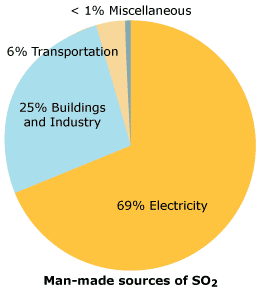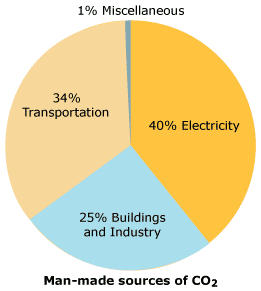Combustion Booklet
- Author:
- Michael Biarnes
- Collaborators:
- Jason Esteves
- Bill Freed
- Download PDF:
- Combustion Booklet 2006 (PDF, 856Kb)
Table of Contents
- Combustion
- Efficiency
- Emissions
- Analysis
- Summary
Emissions of Sulfur Compounds
Sulfur Dioxidereturn
 Sulfur dioxide, SO2, makes up about 95% of all of the sulfur oxides that is released during combustion. SO2 is a main cause of acid rain when it reacts with water vapor. The EPA regulates the emissions of sulfur dioxide through its Acid Rain Program. Most sulfur dioxide is produced through the production of electricity and through industrial processes.
Sulfur dioxide, SO2, makes up about 95% of all of the sulfur oxides that is released during combustion. SO2 is a main cause of acid rain when it reacts with water vapor. The EPA regulates the emissions of sulfur dioxide through its Acid Rain Program. Most sulfur dioxide is produced through the production of electricity and through industrial processes.
Sulfur Trioxidereturn
Sulfur trioxide, SO3, is not abundant in combustion but is problematic as it is a source of corrosion in the cold areas of boilers. In most processes, measuring SO3 emissions is not required, but SO3 should be eliminated to avoid deterioration of parts.
Hydrogen Sulfidereturn
Hydrogen Sulfide, H
Sulfur Oxide Reductionreturn
- Low Sulfur Fuel
- Low sulfur fuel reduces the initial amount of sulfur in the system, therefore lowering the amount of SO2 being released into the atmosphere.
- Fuel Desulfurization
- Fuel desulfurization involves removing some of the sulfur from the fuel before it is burned. Fuel desulfurization is mainly used when coal is the fuel being utilized.
- Flue Gas Desulfurization Systems
- Flue gas desulfurization, FGD, involves the use of scrubbers that chemically react with the SO2 to form other compounds. There are two methods, regenerable FGD and non-regenerable FGD that vary in how much and what kind of waste is produced. This method is very effective and can reduce sulfur oxide emissions by up to 90%.
Best Method to Measuring SO2return
Given the solubility of the SO2 gas, it is imperative that the integrity of the gas sample is maintained and all the water is eliminated under a controlled environment minimizing any contact with the sample gas; this can be achieved by using a similar sampling system as the one discussed to measuring NO2, which should include a Heated Probe, Heated Sample Line, and Chiller.
Carbon Dioxidereturn
 Carbon Dioxide, CO2, is always a byproduct of combustion. The level of carbon dioxide released is dependent upon the type of fuel used and the combustion process. Although naturally produced through respiration and other organic processes, carbon dioxide is a green house gas and thus advances global warming. The primary sources of manmade carbon dioxide are motor vehicles, industries, and electric utilities.
Carbon Dioxide, CO2, is always a byproduct of combustion. The level of carbon dioxide released is dependent upon the type of fuel used and the combustion process. Although naturally produced through respiration and other organic processes, carbon dioxide is a green house gas and thus advances global warming. The primary sources of manmade carbon dioxide are motor vehicles, industries, and electric utilities.
Calculating CO2 (Actual) is a function of the stoichiometric maximum amount of CO2 (Maximum) that can be released by a given fuel and the O2 concentration, as shown in the following equation:
Most combustion processes use fuels, or a combination of different fuels, that have variable amounts of carbon, making the calculation of the CO2 max extremely difficult. With the CO2 max constantly changing, it is impossible to accurately calculate CO2 based on the oxygen levels in the flue gases. In those situations, monitoring the CO2 levels is imperative.
Measuring CO2 is normally achieved by using non-dispersive infrared (NDIR) technology.
return